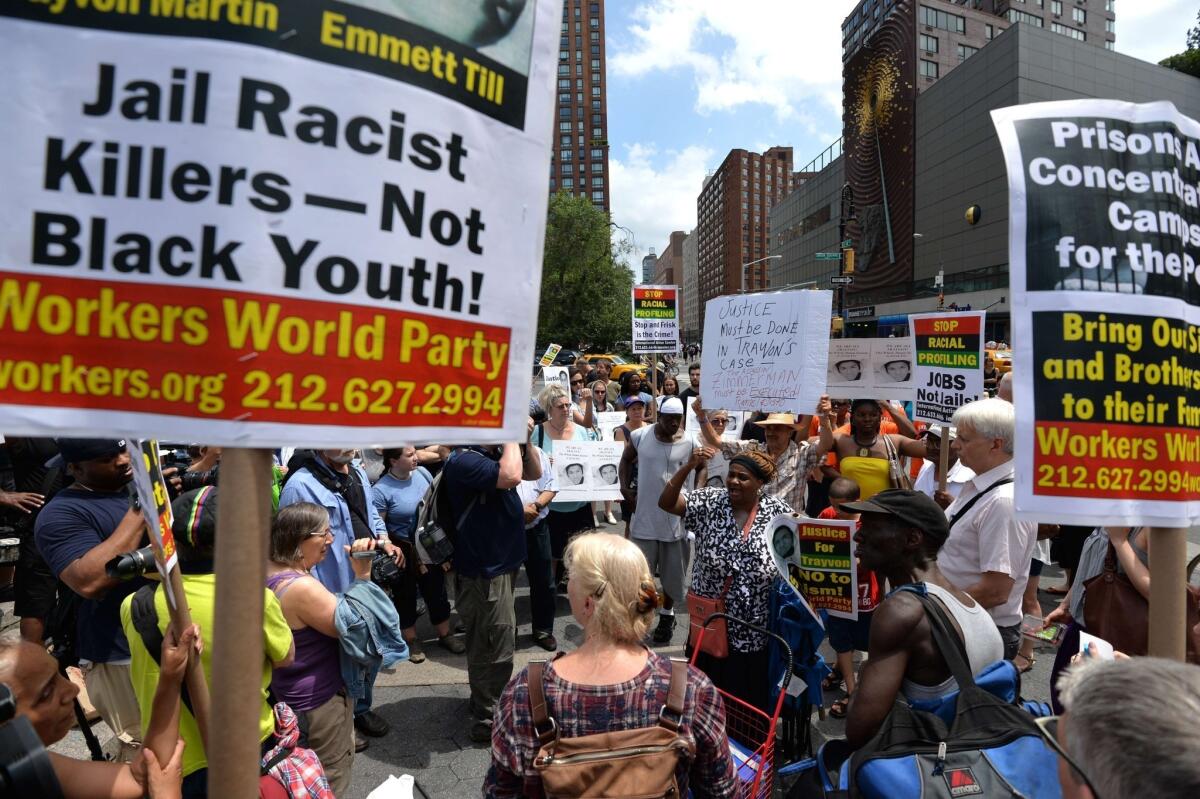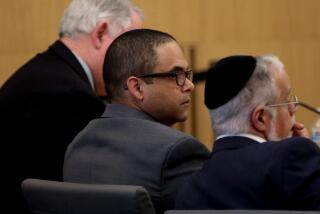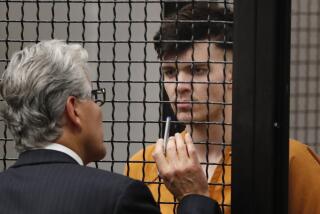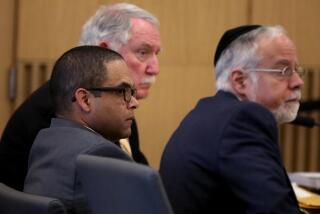George Zimmerman prosecution faced hurdles it couldn’t clear

Lawyers tried to treat it like a routine homicide trial in a small town in Florida, but the George Zimmerman case moved beyond that, becoming part of the national debate on race and violence.
Moments after a six-woman jury returned a verdict of not guilty on all charges, questions began to pop up at news conferences held by the prosecution and defense teams and in cable television commentary as lawyers dissected each side’s legal strategy.
Should Zimmerman have been charged at all and should he have faced such a stringent accusation as murder? What role did race play in deciding how to prosecute the case? Did Florida’s expansive laws allowing a “stand your ground” defense help or hinder the prosecution? What more could the state have done to win a case in which there was a dead African American teenager?
PHOTOS: The controversial case in pictures
From the beginning, there were questions about whether to even charge Zimmerman in the shooting of the unarmed teenager, Trayvon Martin, on a rainy night in February 2012 in Sanford, Fla. Local authorities accepted Zimmerman’s argument that he had shot in self-defense, but a special prosecutor, appointed after weeks of demonstrations by civil rights leaders, came back with a charge of second-degree murder.
In her news conference following the verdict, Angela B. Corey, the state attorney who brought the charges but turned the courtroom battle over to a top deputy, angrily denied any suggestion that Zimmerman was overcharged.
“We charged what we had based on the facts of the case,” she told reporters. “We truly believe the mindset of George Zimmerman and the reason he was doing what he did fit the bill for second-degree murder.”
In Florida, second-degree murder carries a high bar of proof. As Judge Debra S. Nelson described it in her legal directions to the jury, the state had to prove Zimmerman acted with ill will, spite or hatred when he shot Martin. Prosecutors eventually asked the judge to allow jurors to also consider a lesser charge, manslaughter, which only requires that the state show that Zimmerman shot without lawful justification.
Late in its deliberations, jurors asked the judge for a clarification of what constitutes manslaughter. The judge sent back a note, written by the opposing lawyers, saying that she could only answer a specific question. The jury never responded. After dinner they sent back a message that they had reached a decision.
For the defense, the racial overtones were always an issue. It sought to bar the prosecution from using the term “racial profiling” in describing Zimmerman’s action that night. Nelson ruled the prosecution could use the word profile, without the modifier of race.
Profiling became a key element of the prosecution case. It argued that Zimmerman saw Martin, profiled the teenager, who was wearing a hoodie, and tracked him through the gated community of The Retreat at Twin Lakes despite a police operator’s advice that he stay away and let cops handle the situation.
Zimmerman is not a racist, his attorney Mark O’Mara told reporters after the verdict, and the lawyer rejected any suggestion that Zimmerman had profiled Martin. Still, race played a part in bringing the charges, he said.
“This became a focus for a civil rights event, which is a wonderful event to have,” O’Mara said, arguing that if Zimmerman had been black, he likely would never have been charged. During the trial, prosecutor John Guy said the same to the jury but with a different twist: What would have been the verdict if Martin had followed and shot Zimmerman, who is a light-skinned Latino?
Initially there were questions whether Florida’s stand your ground law would be invoked by the defense. The law broadens the grounds a defendant can argue in a claim of self-defense and allows a special hearing before a judge. But the defense waived that right, choosing instead to make its self-defense argument directly to a jury. Despite the earlier furor over Florida’s laws, stand your ground did not play any role in setting the legal arena where the case was fought.
With explicit mention of race ruled out and the option on self-defense waived, the sides prepared to fight the case on the traditional grounds: Who did what to whom and why?
In addition to having to prove Zimmerman acted with a “depraved mind,” to meet the second-degree murder charge, the prosecution was limited by the circumstances of the case. Aside from pressing for sympathy for the slain Martin, the prosecution argued that the confused events of the night of Feb. 26 were only known by two people, and “one is dead and the other is a liar.”
The case for Zimmerman being a liar rested on physical and recorded evidence. Zimmerman gave police several statements and even walked them through the shooting area the next day. That tour was recorded by video and was shown to the jury, which also heard all of the 911 calls and received the written statements that Zimmerman made to police.
In the statements, Zimmerman insisted he shot in self-defense but gave different versions of the details. In one he claimed that he was just walking in the same direction as Martin when he was attacked. In one statement he said numerous blows were delivered and that Martin repeatedly pounded his head onto the concrete. The prosecution pointed out every inconsistency and argued that the extent of Zimmerman’s injuries -- a bloody nose and two lacerations to the back of the head -- showed that any fight had resulted in minor injuries.
The prosecution also argued at one point that Zimmerman’s claim that Martin was on top hitting him repeatedly was untrue. Using a pliable foam dummy, the prosecution tried to show that Zimmerman could not reach his gun in his waistband to shoot Martin if he was being straddled as the defense maintained.
But more than two weeks of testimony by more than 55 witnesses could not resolve the key questions of what actually happened that night when Zimmerman and Martin had their confrontation. Neither side could prove who did what, who threw the first punch, or who screamed for help. There were no direct eyewitnesses to the initial meeting.
The state’s case was strong on theory, but non-existent on proof, O’Mara argued in his closing. “Don’t connect those dots unless they are connected for you, beyond a reasonable doubt, by the state,” he urged the jurors in a repeated theme.
Among those dots was the state’s contention that Zimmerman was a wannabe cop, fed up with crime in his community, who had taken matters into his own hands and went after the innocent teenager, Martin. Neither had the state provided a “shred of evidence” to disprove the defense’s contention that Zimmerman was just returning to his vehicle when Martin attacked, O’Mara said.
If the prosecution’s case was circumstantial, so was the defense’s. The defense was especially strong in undermining some of the prosecution witnesses -- especially two, Rachel Jeantel, Martin’s friend who spoke to him by cellphone during the moments before he died, and the state’s forensic expert.
It was Jeantel, 19, who described how Martin fearfully told her that he was being followed by a “creepy-assed cracker.” Martin explained how scared he was, potentially crucial testimony in establishing that Zimmerman was the aggressor.
But in some nine hours of cross-examination over two days, defense attorney Don West undermined her credibility by getting her to admit she had lied about some things. Jeantel admitted that she had lied about her age and why she did not attend the wake for Martin. She also acknowledged that she had initially told a slightly different story of the conversation because she did not want to upset Martin’s mother, Sybrina Fulton, who was sitting next to her.
The defense also hit at the prosecution witnesses, describing the lack of blood and DNA evidence. The defense got most to agree that the evidence could have been degraded by the rain that night and the plastic bags in which garments were stored. The plastic bags allowed mold to possibly destroy evidence. Even the state’s medical examiner, Dr. Shiping Bao, agreed that the evidence could have been damaged.
Bao didn’t help the state when he also testified that he remembered nothing about the autopsy of Martin, except what was in the notes he made.
By contrast, the defense’s pathologist, Dr. Vincent Di Maio, a well-known expert who had testified in many cases including the Los Angeles murder case of record producer Phil Spector, was an advantage. He explained how all of the forensic evidence was consistent with Zimmerman’s version of events, including that it was Martin on top beating Zimmerman.
The defense was also helped by testimony from a prosecution witness, resident John Good, who said he saw the fight. The person on top was wearing a dark garment, similar to Martin’s hoodie, he said. The person on the bottom was crying out.
A 911 call caught the screams in the background. The prosecution insisted it was Martin’s voice, while the defense argued it was Zimmerman’s. The state had several experts prepared to testify that it was the teenager’s voice but the defense questioned their methodology. Nelson ruled in the defense’s favor and kept the state’s experts out.
That left the question of the voices up to relatives. Each side brought in the mothers: Fulton, and Gladys Zimmerman, George’s mom. They testified that the voice was their son’s. Other relatives and friends backed up their respective families. But exactly who is the screaming voice was not resolved by any independent means.
After the verdict was returned on Saturday night, hugs and kisses erupted on the Zimmerman side of the courtroom while supporters of the Martin family left, many with heads down, and some crying.
“George Zimmerman was never guilty of anything except protecting himself in self-defense,” O’Mara said.
Benjamin Crump, an attorney for the Martin family, spoke of lessons learned.
“All of America has to dig deep in their heart to find out how we can learn from this tragedy and make sure it’s not repeated,” Crump said.
ALSO:
Zimmerman not guilty: Reactions include joy, tears, disbelief
George Zimmerman’s acquittal: Nation reacts to not-guilty verdict
Zimmerman lawyer calls prosecution ‘disgraceful’; Martin lawyer calls for calm
More to Read
Start your day right
Sign up for Essential California for news, features and recommendations from the L.A. Times and beyond in your inbox six days a week.
You may occasionally receive promotional content from the Los Angeles Times.







